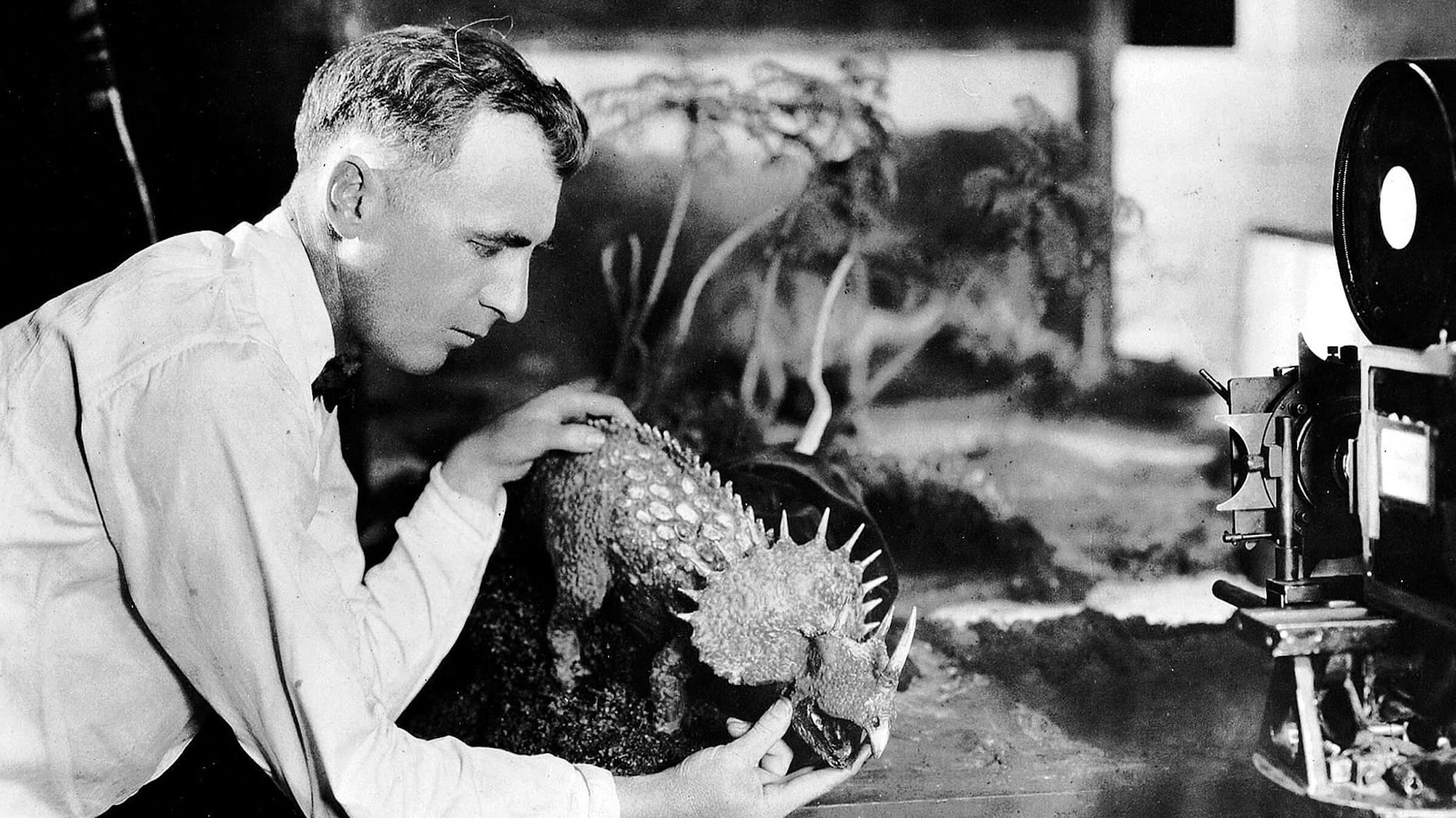This feature was published in conjunction with the screening of The Lost World at SFSFF 2017
In the annals of film history, Willis O’Brien is considered a visionary in the field of stop-motion animation, most famous for his state-of-the-art monsters in 1933’s King Kong. His experimentation with models of prehistoric creatures can be traced back to his first film short in 1915 and the subsequent “Stone Age” one-reelers he made for the Edison Company. However, his collaboration with film producer Herbert M. Dawley on the more ambitious The Ghost of Slumber Mountain (1918) ended badly, with Dawley removing O’Brien’s credit from the film. Dawley later attempted to block the release of The Lost World claiming patent infringement over a dinosaur model Dawley named his “Articulated Effigy.” For years Dawley has been portrayed as the villain to O’Brien’s wronged artist, but research by late sculptor and special-effects artist Stephen Czerkas (Planet of Dinosaurs), the first to gain access to the papers of Dawley (and other producers), tells a more complete story.
From 1907 to 1916, Herbert M. Dawley works for Pierce-Arrow Motor Car Company in the nascent years of the automobile industry. He becomes one of its most important designers, bringing a high level of artistry to the look of its model line.
Willis O’Brien leaves home at an early age, working as a ranch hand, animal trapper, wilderness guide, bartender, professional boxer, draftsman, cartoonist, and brakeman before settling down in San Francisco in 1914 as a sculptor.
Dawley leaves Pierce-Arrow to set up a motion picture company with his wife Verne in Chatham, New Jersey, in 1917. His interest in dinosaurs leads him to construct a brontosaurus model that he photographs with a Kodak camera, assembling the stills as a flip-book. He begins to further explore stop-motion animation.
O’Brien, an avid fan of movies, begins to experiment with photography and special effects using miniature clay figurines. A one-minute test film of a brontosaurus moving against a prehistoric backdrop convinces movie exhibitor Herman Wobber to help fund O’Brien’s first short, The Dinosaur and the Missing Link (1915). The Edison Company purchases the short for distribution and hires O’Brien to create a series of Stone Age shorts (1916–1917).
Dawley sees O’Brien’s work for the Edison Company and approaches him in 1918 about working together on a film. O’Brien agrees, as he has been laid off by Edison during a downsizing phase.
O’Brien and Dawley make The Ghost of Slumber Mountain for which Dawley serves as producer, director, and special-effects supervisor with O’Brien as his assistant to receive screen credit for photography and mechanical effects.
The November 1918 premiere of the film at the Strand Theatre in New York is a financial and critical success, but Dawley, away on emergency duty with the New Jersey Militia in the final phase of postproduction, is shocked to discover that O’Brien has distributed programs claiming total credit for the completed film. He also learns that O’Brien is now under contract to Watterson R. Rothacker, a prominent film industrialist who hired O’Brien during production of Slumber Mountain without Dawley’s knowledge.
Stung by O’Brien’s disloyalty, Dawley removes O’Brien’s name from the film and closes a deal in May 1919 to distribute The Ghost of Slumber Mountain through the Inter-Ocean Film Company. Rothacker tries unsuccessfully to block its distribution and counters with industry ads in June 1919 dismissing Dawley’s claims while promoting O’Brien as the true producer-director of the movie.
Dawley embarks on Along the Moonbeam Trail (1920), a two-reeler in which two brothers are transported to the moon and encounter prehistoric creatures. Dawley creates all the dinosaur puppets and animates them in a stop-motion process, receiving an official patent in 1920 for the Articulated Effigy.
Rothacker purchases the rights to Arthur Conan Doyle’s 1912 novel The Lost World and works with O’Brien under a cloak of secrecy to adapt it for the screen. Looking for investors, he signs independent producer Cathrine Curtis in July 1920 with the understanding that O’Brien’s involvement is crucial to the film’s success.
In January 1921, Curtis views a copy of The Ghost of Slumber Mountain and is puzzled by the omission of O’Brien’s screen credit. Her investigation into the matter convinces her that Dawley’s claims are justified and she tries to negotiate a solution to allow The Lost World to proceed without lawsuits but is unsuccessful. (She later produced King Vidor’s 1921 film The Sky Pilot and, during the 1930s, was a radio commentator for the American Broadcasting System.)
Dawley teams up with renowned puppeteer Tony Sarg on a series of “Shadowgraph” shorts entitled Tony Sarg’s Almanac (1921–1923).
At a meeting of the Society of American Magicians on June 3, 1922, Conan Doyle amazes the gathering with realistic film footage of dinosaurs, which was ostensibly taken from O’Brien’s work-in-progress The Lost World. Dawley learns about the publicity stunt and threatens to Sue Rothacker for $100,000 in damages and seeks an injunction against the film’s completion, claiming that he had invented the basic design for the animated models they are using in The Lost World.
After months of legal sparring, the case is finally settled out of court and The Lost World is completed and released to great acclaim in 1925. By this time, Dawley was deeply immersed in a theatrical career, having cofounded the Chatham Community Players in New Jersey in 1922 and he spent the next fifty-two years directing plays.

